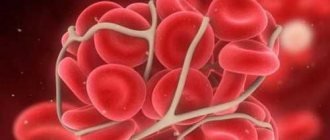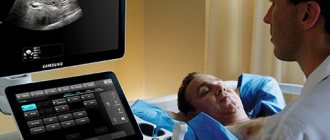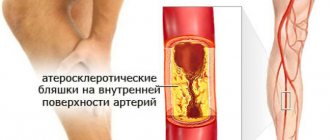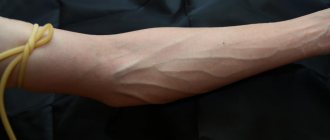The problem of deep vein thrombosis of the lower extremities (DVT) and subsequent pulmonary embolism (PE) in the postoperative period has been and remains one of the most pressing in modern surgery.
According to domestic and foreign authors, depending on the type of surgical interventions and risk factors in patients, the incidence of DVT reaches 10 - 60%, and fatal pulmonary embolism occurs in 1 - 5% of cases.
In this regard, the prevention of venous thromboembolic complications in the pre- and postoperative period becomes extremely important.
Prevention of thrombosis and thromboembolism in various groups of patients
All patients, regardless of risk group, require elastic bandaging of the limbs with long-stretch bandages. The bandage is applied from the fingers to the upper third of the thigh. Compression should be carried out before the operation, during it and then continuously, day and night, until the patient is adequately activated (that is, when he begins to walk fully). It is permissible not to use compression in patients undergoing minor surgical interventions on an outpatient basis (ingrown toenails, small lipomas, etc.).
A healthy lifestyle as the main preventive measure
· To give up smoking. When you inhale tobacco smoke, tars penetrate through the walls of the lungs into the bloodstream and injure the vascular walls. The risk of thrombosis increases significantly. If it is impossible to get rid of nicotine addiction on your own, seek help from appropriate specialists.
· Rational diet. If you are overweight, there is guaranteed to be congestion in the lower extremities, which impairs blood flow. The slower it is, the higher the risk of blood clots. Weight control and moderate physical activity are the most important measures against thrombosis.
· Active lifestyle. Daily physical activity is an integral part of a healthy lifestyle. Walking, cycling, jogging - all this protects not only from thrombosis, but also from their provoking factors, including obesity. In patients with physical inactivity, the risk of vascular pathologies almost doubles.
· Limit the consumption of alcoholic beverages. Alcohol consumed on a regular basis saturates the blood with toxic substances that have a destructive effect on the walls of blood vessels. The likelihood of thrombosis increases significantly.
· Monitoring blood pressure levels. If you have problems with blood pressure, you should constantly monitor its level using a home blood pressure monitor. If there is a need to reduce it, consult a doctor - do not take measures to self-medicate.
· Taking into account family history. If close relatives have diseases associated with abnormal coagulation, it is important to inform the observing specialist about this circumstance. Carefully monitor your health if you have a genetic predisposition to diabetes and other chronic diseases that cause vascular problems.
· Postoperative measures. As a result of any surgical intervention, the integrity of healthy tissue is compromised, which can affect the process of blood clot formation. Consult your doctor in advance about short-term use of anticoagulants and other protective measures during postoperative rehabilitation.
· Rules for flights and transfers. In case of constant flights and transfers (more than 4 hours on the road), monitor the normal position of your legs and try to consume more fluid - dehydration can thicken the blood, which is a favorable factor for the formation of blood clots and emboli.
· Refusal of COCs (combined oral contraceptives). If you have a hereditary tendency to thrombosis, or have a history of them, you need to stop using hormonal contraception. Pills taken to protect against unwanted pregnancy, in almost all cases, carry with them a side effect in the form of impaired blood clotting and thickening. This is especially true for smokers and women over 35 years of age. Discuss alternative methods of contraception with your gynecologist.
Check with your vascular surgeon or phlebologist about what measures to prevent thrombosis you should take during pregnancy. Such recommendations are traditionally given on a personal basis, taking into account the course of pregnancy and related problems.
Uncontrolled use of hormonal contraceptives
Due to the high content of estrogen, some contraceptives activate the blood coagulation system, which results in the formation of blood clots.
How to warn. Avoid long-term uncontrolled use of hormonal contraceptives, which are contraindicated in case of varicose veins, thrombophlebitis, acute liver diseases, diabetes mellitus, and malignant diseases. Therefore, before prescribing them, it is necessary to undergo an examination: look at the condition of the liver, mammary glands, hemostasis, and do an ultrasound of the female genital organs. And repeat these studies annually.
By the way
In addition to the reasons listed above, the following are also at risk of developing venous thromboembolism: patients with atrial fibrillation, heart failure; pregnant women; obese people; patients with diabetes mellitus; heavy smokers.
Thrombophlebitis: prevention
Since thrombophlebitis is the most common complication of varicose veins, all measures that prevent varicose veins and stagnation of blood in the veins will be effective in preventing this disease. Moderate but regular physical activity, weight control, absence of prolonged static tension, a balanced diet, as well as wearing properly selected compression hosiery will help you prevent the onset or progression of varicose veins. They will also serve as a good prevention of thrombophlebitis.
If you already have a diagnosis of varicose veins, try to prevent the disease from progressing. Here, wearing compression hosiery plays an important role, which normalizes blood circulation in the veins. Don't forget to wear knitwear if you have a long plane flight or train journey. A forced sitting position during a move or flight, often uncomfortable, provokes thrombophlebitis. You should also avoid lifting heavy objects and allowing sudden temperature changes - thrombophlebitis can be caused by overheating in a sauna or too much sunbathing.
Ways to prevent thrombosis after operations and injuries
If you require surgery or have suffered a serious injury, your doctor will need to take a detailed look at your medical history and decide on how to protect against thrombosis. The risk of deep vein thrombosis is associated with limited mobility after surgery and injury. Usually it increases immediately after the intervention and during the first 10 days after it, but can persist for up to several months, especially with forced physical inactivity.
Practical studies show that the risk of thrombosis is significantly reduced when using regional (conduction) anesthesia. Therefore, modern specialists prefer it if it is possible to bypass the use of general anesthesia.
The list of postoperative and post-traumatic preventive measures also includes:
· Taking anticoagulants (strictly as prescribed);
· Wearing elastic compression and bandage underwear;
· Elevated position of the legs during rehabilitation;
· Early physical activity (at the first opportunity);
· Painkillers to facilitate movement;
· Physical therapy under the supervision of an instructor.
Compression hosiery and other auxiliary products should be selected by a specialist, taking into account individual measurements.
Thromboembolism: how to prevent trouble?
The ability of blood to clot is one of the unique properties of the body. Without exaggeration, it can save a person’s life. But it also happens that a blood clot appears in the wrong place, creating a threat to health, and sometimes even life.
We are talking about a serious pathology - thromboembolism - with the cardiovascular surgeon of the Expert Clinic Kursk Maxim Yuryevich Gordov.
“Just a minute ago, a man was talking and even laughing, singing or dancing, and suddenly he began to choke and died. This is how eyewitnesses describe what happened. Maxim Yurievich, what is thromboembolism?
The description is true. Pulmonary embolism (PE) is a serious complication that develops as a result of the formation of blood clots in the veins of the lower limb, in the cavities of the heart and their subsequent entry into the pulmonary artery system.
The above example exactly corresponds to the manifestations of thromboembolism of this artery.
— Are thromboembolism and thrombosis the same thing or are they different diseases?
Thrombosis and embolism are closely interrelated, because the first pathology almost always gives rise to the second. Thrombosis is called intravital blood coagulation in the lumen of a vessel with partial or complete blockage of its lumen, leading to disruption of blood flow. The blood clot that forms is called a thrombus.
Embolism is the blockage of blood vessels by particles carried by the bloodstream and not usually found in the blood. The transferred particles are called emboli. Thromboembolism is the separation of pieces of blood clots from the site of formation and entry into the blood vessels.
“The most dangerous complication is venous thrombophlebitis and blood clot rupture. If carried away by the bloodstream, such blood clots can block the pulmonary artery and lead to death.” Quote from the material “All about varicose veins of the legs: looking for causes and finding treatment methods”
In both cases, the consequence is partial or complete closure of the lumen of the vessel and a deterioration in the supply of oxygen and nutrients to the tissues that supplied blood to this vessel.
— What is the “catalyst” for the development of thromboembolism?
The main factors that cause thromboembolism may include:
— surgical operations accompanied by the use of general anesthesia and immobilization of the patient;
- stroke. With it, the patient can also lie for a long time;
— serious pathologies of the heart muscle: chronic heart failure, atrial fibrillation (one of the types of heart rhythm disturbances. In this case, blood clots can form in the cavities of the heart and there is a possibility of them breaking off and being carried into the vessels);
– the presence of cancer with corresponding disorders in the blood coagulation system.
— What happens to the body when thromboembolism occurs?
If, for example, we are talking about pulmonary embolism, then classic PE is characterized by the following signs:
— shock (possible loss of consciousness);
- tachycardia (increased heart rate);
- hypotension (low blood pressure).
These signs do not always exist, and, in addition, sometimes others simply do not have time to see them.
In case of thromboembolism of the arteries of the systemic circulation (brain, arms, legs, celiac trunk), manifestations characteristic of these areas will be noted. For example, with thromboembolism of a vessel in the brain, an ischemic stroke will develop with corresponding neurological disorders.
— According to statistics, thromboembolism causes 30% of all sudden deaths. Why is this disease so common?
This, among other things, is a low level of thromboembolism prevention - for example, inappropriate use of anticoagulants (blood thinners), late activation of the patient after surgery, untreated cardiac pathology.
— Who is at risk for developing thromboembolism?
Persons who have, in particular, the risk factors for the occurrence of this pathology that I mentioned earlier, i.e.:
- have undergone surgery, stroke and subsequently remain immobile for quite a long time;
- having serious diseases of the heart muscle (for example, chronic heart failure, atrial fibrillation).
If signs of thromboembolism appear, you must immediately call an ambulance team
— Does thromboembolism always occur suddenly or are there any symptoms by which one can recognize an impending catastrophe?
Unfortunately, it is impossible to recognize the approach in advance. Those. if we see something, it means that the process has already started. This always happens quite abruptly and unexpectedly.
— Maxim Yuryevich, what should you do when alarm signals appear?
Immediately call an ambulance or, if possible, quickly take the person to the hospital yourself.
— If thromboembolism has already occurred, is it possible to help the person? Can doctors cure such a patient?
This depends on a number of factors - in particular, on the area of the lesion, the massiveness of the blockage of blood vessels, and the time of initiation of assistance. Anticoagulants are usually prescribed as medications. If there are blood clots in the venous system of the lower extremities, sometimes, according to indications, so-called vena cava filters are placed in the inferior vena cava (where venous blood flows from the legs). They are able to “catch” blood clots that have come out of the veins of the lower limb and prevent them from entering the pulmonary artery system.
In case of thromboembolism of an artery of a limb (any), an operation to remove the embolus (embolectomy) is performed.
If the blood clot is located in a cerebral vessel, such a patient is treated according to the principles of stroke management. In particular, in the first hours an attempt may be made to dissolve the blood clot (thrombolysis).
“In an ischemic stroke, doctors have 4.5 hours (the so-called “therapeutic window”) to restore the patency of the vessel and prevent damage to part of the brain.” Quote from the material “When the goal is not for the good. Why does a stroke strike?
— How to properly carry out early preventive measures in order to protect against thromboembolism?
To prevent pulmonary embolism in people at risk, which I mentioned earlier, timely administration of anticoagulants, early activation after surgery, and, if necessary, massage and physiotherapeutic procedures, kinesitherapy are used. According to indications, a vena cava filter can be installed in the inferior vena cava.
Regardless of the type of vessel, to prevent thromboembolism it is also necessary to adequately and promptly treat any diseases that increase the risk of blood clots.
For reference:
Gordov Maxim Yurievich
Graduate of the Faculty of Medicine of Kursk State Medical University in 2013.
From 2013 to 2015, he completed clinical residency in the specialty “Cardiovascular Surgery”. Candidate of Medical Sciences.
Currently working at Clinic Expert Kursk as a cardiovascular surgeon.
Receives at the address: st. Karl Liebknecht, no. 7.
Other materials on topics:
What prevented Leonid Gaidai from moving forward?
Take care of your vessels! How not to miss vascular diseases of the brain?
Coronary heart disease: diagnosis and treatment









